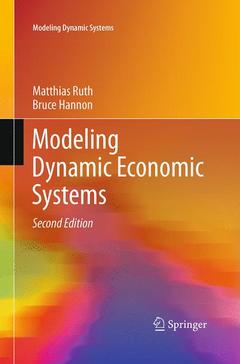Description
Modeling Dynamic Economic Systems (2nd Ed., 2nd ed. 2012)
Modeling Dynamic Systems Series
Authors: Ruth Matthias, Hannon Bruce
Language: English
Subjects for Modeling Dynamic Economic Systems:
Keywords
68.56 €
In Print (Delivery period: 15 days).
Add to cart
Modeling Dynamic Economic Systems
Publication date: 02-2012
Support: Print on demand
Publication date: 02-2012
Support: Print on demand
Approximative price 94.94 €
In Print (Delivery period: 15 days).
Add to cart
Modeling dynamic economic systems
Publication date: 02-2012
326 p. · 15.5x23.5 cm · Paperback
Publication date: 02-2012
326 p. · 15.5x23.5 cm · Paperback
Description
/li>Contents
/li>Comment
/li>
This book explores the dynamic processes in economic systems, concentrating on the extraction and use of the natural resources required to meet economic needs. Sections cover methods for dynamic modeling in economics, microeconomic models of firms, modeling optimal use of both nonrenewable and renewable resources, and chaos in economic models. This book does not require a substantial background in mathematics or computer science.
Foreword.- Preface.- Notation.- Part I: Introduction.- Modeling Dynamic Systems.- Disaggregation of Stocks.- Part II: Methods for Dynamic Modeling.- System Boundaries in Space and Time.- Scheduling Flows.- Positive Feedback in the Economy.- Derivatives and Lags.- Part III: Microeconomic Models of Firms.- Introduction to Modeling Economic Processes.- Substitution of Inputs in Production.- Time Value.- Opportunity Cost.- The Profit-Maximizing Competitive Firm.- The Profit-Maximizing Monopoly.- Monopolistic Collusion.- Quasi-Competitive Equilibrium.- Modeling Economic Games.- Part IV: Modeling Optimal Use of Nonrenewable Resources.- Competitive Scarcity.- Competitive Scarcity with Substitution.- Competitive Scarcity with Cost Dependent on Production Rate and Resource Size.- Competitive Scarcity with Technical Change.- Competitive Scarcity with Exploration.- Monopoly Scarcity.- Monopoly Scarcity with Variable Interest Rate.- Monopoly Scarcity with Cost Dependent on Production Rate and Resource Size.- Part V: Modeling Optimal Use of Renewable Resources.- Optimal Timber Harvest.- Managing Open Access Resources.- Optimal Harvest from Fisheries.- Spatial Fishery Model.- Part VI: Chaos in Economic Models.- Preference Cycles and Chaos.- Nonmonotonic Demand and Supply Curves.- Price Expectation and Production Lags.- Chaos in Macroeconomic Models.- Part VII: Conclusion.- Building a Modeling Community.- References.- Index.
Models in this book were created using STELLA software The authors have updated this book so that it is more accessible to students studying model development This book models and analyzes the dynamics characteristic of economic processes and human-environment interactions Includes supplementary material: sn.pub/extras
© 2024 LAVOISIER S.A.S.




